SARS-CoV-2 and COVID-19
SARS-CoV-2 is the biological agent responsible for the disease COVID-19. As the virus is a novel virus (i.e. one that has not previously been identified in humans), research on the virus is still on-going.

The virus is primarily transmitted between people through the respiratory route via droplets, which can be generated by coughing, sneezing, laughing or talking and also the contact route (touching something with the virus on it, then touching your mouth, nose or eyes before washing your hands). The transmission risk is highest where people are in close proximity (within 2 metres).
Who is at Risk
The virus can infect people of all ages but not everyone infected develops disease. Two groups of people have been identified as being at a higher risk of getting severe COVID-19 disease:
- Older people (that is people over 60 years old); and
- People with underlying medical conditions (such as cardiovascular disease, diabetes, chronic respiratory disease, and cancer).
Healthcare workers and workers who work in close proximity to one another, such as in food and meat processing plants, appear to be at increased risk of infection.
Airborne transmission can occur in healthcare settings where procedures or support treatments that generate aerosols are performed. Airborne transmission may also occur in poorly ventilated indoor spaces, particularly if individuals are in the same room together for an extended period of time.
Preventing Infection
- Follow public health guidance especially with regard to home working, social/physical distancing, use of face coverings, good hand hygiene and cough and sneeze etiquette.
- Separate people from each other or shared surfaces through physical distancing and physical barriers.
- Ensure physical distancing measures are in place especially in vehicles, restrooms, locker rooms, lifts, hallways, canteens, offices and meeting rooms.
- Implement one way walking routes where possible to limit people having to pass close to one another.
- Provide adequate ventilation with fresh air.
- Ensure warm running water, soap and disposable towels are available for hand washing. Use hands free operated taps, toilet flushes, door accesses etc. where possible.
- Provide alcohol-based sanitiser dispensers, ideally with hands free operation, in prominent places in the workplace, for example at the entrance to the workplace. Note: alcohol is flammable so care must be taken when siting and storing such products. Do not place or store them near sources of heat, sunlight, ignition sources (light switches, electrical outlets) or next to medical gas or oxygen outlets.
- Regularly clean and disinfect (where required) frequently used areas, frequently touched surfaces and shared tools. Pay particular attention to equipment, plant or machinery that may be shared. If using a disinfectant, ensure that it is active against SARS-CoV-2 (an enveloped or lipid virus).
- Stagger shifts and breaks and split working crews (if safe to do so) to avoid large congregations of workers together.
- Provide instruction, information and training to staff with respect to the virus, the signs and symptoms of disease and the prevention measures. This must be provided in a manner and format that is reasonably likely to be understood. For employees with poor language skills or where English is not their main language, this may mean providing pictorial information or translating the information into a language that can be understood.
- Identify a space/isolation room where employees or clients can be isolated from others if they develop symptoms.
- Ensure safety supervision is in place to ensure control measures are adhered to. The lead worker representative will have a role here.
